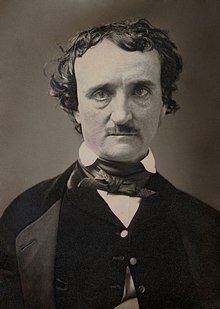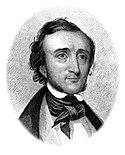
Back Edgar Allan Poe Afrikaans ኤድጋር አለን ፖ Amharic Edgar Allan Poe AN Eadgar Allan Poe ANG إدغار آلان بو Arabic ادجار الان بو ARZ Edgar Allan Poe AST Edgar Allan Poe AVK Edgar Allan Poe Aymara Edqar Allan Po Azerbaijani
Edgar Allan Poe | |
|---|---|
 Poe in 1849 | |
| Born | Edgar Poe January 19, 1809 Boston, Massachusetts, U.S. |
| Died | October 7, 1849 (aged 40) Baltimore, Maryland, U.S. |
| Resting place | Westminster Hall and Burying Ground, Baltimore |
| Spouse | |
| Parents | |
| Relatives |
|
| Signature | |
 | |
 |
| Topics related to |
| Edgar Allan Poe |
|---|
| In popular culture |
| In music |
| In television and film |
| Dark Romanticism |
| Edgar Awards |
| Death |
| Bibliography |
Edgar Allan Poe (né Edgar Poe; January 19, 1809 – October 7, 1849) was an American writer, poet, editor, and literary critic who is best known for his poetry and short stories, particularly his tales involving mystery and the macabre. He is widely regarded as one of the central figures of Romanticism and Gothic fiction in the United States, and of early American literature.[1] Poe was one of the country's first successful practitioners of the short story, and is generally considered to be the inventor of the detective fiction genre. In addition, he is credited with contributing significantly to the emergence of science fiction.[2] He is the first well-known American writer to earn a living by writing alone, which resulted in a financially difficult life and career.[3]
Poe was born in Boston. He was the second child of actors David and Elizabeth "Eliza" Poe.[4] His father abandoned the family in 1810, and when Eliza died the following year, Poe was taken in by John and Frances Allan of Richmond, Virginia. They never formally adopted him, but he lived with them well into young adulthood. Poe attended the University of Virginia, but left after only a year due to a lack of money. He frequently quarreled with John Allan over the funds needed to continue his education as well as his gambling debts. In 1827, having enlisted in the United States Army under the assumed name of Edgar A. Perry, he published his first collection, Tamerlane and Other Poems, which was credited only to "a Bostonian". Poe and Allan reached a temporary rapprochement after the death of Eliza Poe in 1829. However, Poe later failed as an officer cadet at West Point, declared his intention to become a writer, primarily of poems, and parted ways with Allan.
Poe switched his focus to prose, and spent the next several years working for literary journals and periodicals, becoming known for his own style of literary criticism. His work forced him to move between several cities, including Baltimore, Philadelphia, and New York City. In 1836, when he was 27, he married his 13-year-old cousin, Virginia Clemm. She died of tuberculosis in 1847.
In January 1845, he published his poem "The Raven" to instant success. He planned for years to produce his own journal The Penn, later renamed The Stylus. But before it began publishing, Poe died in Baltimore in 1849, aged 40, under mysterious circumstances. The cause of his death remains unknown and has been attributed to many causes, including disease, alcoholism, substance abuse, and suicide.[5]
Poe’s works influenced the development of literature throughout the world and even impacted such specialized fields as cosmology and cryptography. Since his death, he and his writings have appeared throughout popular culture in such fields as art, photography, literary allusions, music, motion pictures, and television. Several of his homes are dedicated museums. In addition, The Mystery Writers of America presents an annual Edgar Award for distinguished work in the mystery genre.
- ^ Sun, Chunyan (April 23, 2015). "Horror from the Soul—Gothic Style in Allan Poe's Horror Fictions" (PDF). English Language Teaching. 8 (5). Canadian Center of Science and Education. doi:10.5539/elt.v8n5p94. ISSN 1916-4742.
- ^ Stableford 2003, pp. 18–19.
- ^ Meyers 1992, p. 138.
- ^ Semtner, Christopher P. (2012). Edgar Allan Poe's Richmond: the Raven in the River City. Charleston, SC: History Press. p. 15. ISBN 978-1-60949-607-4. OCLC 779472206.
- ^ Cite error: The named reference
Meyers256was invoked but never defined (see the help page).
© MMXXIII Rich X Search. We shall prevail. All rights reserved. Rich X Search